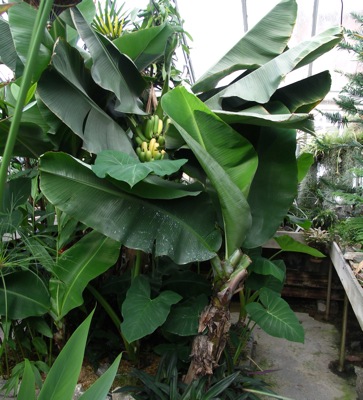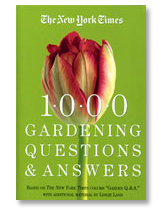Eric’s Pet Plant: Banana
This week, my friend Eric over at Yale has his mind on disappearances: the original completion date for the new greenhouse, the promise of post-construction peace and more worryingly, several rare cactuses stolen by someone who obviously knew just what they were after. But thanks to a glitch he will describe ( and fortunately for us) he also found himself thinking about bananas.

The banana at Marsh Garden
BANANA
Musa species
By Eric Larson
First, some scheduling news: The construction process has run into some delays, and like the former congressman from Texas this unpleasantness too shall pass. Therefore our grand opening date of Dec. 4 is now officially an impossibility. We have tentatively re-scheduled this gala event for Friday, Dec. 18. So, using pencil, put us down on the third Friday of December, from 4 to 7. More on this important event in coming weeks.
As some of you may know, we had a break-in and theft at the greenhouse just about six weeks ago. By the time the news got to the Yale community, we had moved on to other pressing issues such as the amount of fine dust we can collect from the construction project that is making our lives so pleasant here. A young reporter came by from the Yale Daily News and interviewed us about the burglary. She did an excellent job of reporting but somehow the caption under the photograph that accompanied the article mislabeled the plant that I was perusing as a banana.
Actually the long tube-like structures were the insect-catching modified leaves of Nepenthes. If I had been able to correct this, I would have substituted a picture of a real banana, taken my perfect-for-radio face out of the frame and inserted one of the more pulchritudinous members of the staff. But that was not up to me; all I can do is take this opportunity to write about the real thing.
The word banana comes to us down the ages (late 16th Century) through Iberian from a West African language (possibly Wolof) word for the fruit. This is a clue as to the native area of the banana, which is West Africa, east to Cameroon and Gabon, where the coast dips southward. The genus name comes probably from the Arabic, Persian or Turkish names for the plant, all of which are very similar: mawz, mauz and muz respectively. The nomenclature shows how important the Arabic or Muslim influence was in the dissemination of trade goods and culture during those times.
Now of course bananas are cultivated worldwide in the tropical and even sub-tropical zones. They are grown in 108 different countries with India being the largest producer. The global total for production in 2007 in metric tons was 72.5. That’s a lot of bananas. However because of the banana’s complex botany and systematic relationships, the world production of what most of us think of when we think “banana” is in jeopardy.
BANANA COMPLEXITY EXPLORED
There is a wide array of banana types, with plantains, bananitos, bananas and others having a diverse set of eating and/or cooking properties. In East Asia, the fruit is often eaten cooked, with both the inner flesh and the skin being used. The firmer starchier cultivars of the species are called plantains, which are often cooked. The banana that is most often found in supermarkets in the suburbs of this country is called the ‘dessert’ banana.
Bananas as we know them, and by this I refer to the ‘dessert’ bananas, were considered a separate species when first deliberated by Carl Linnaeus. But the relationship between banana and humankind is a long one and very complex, involving hybridization, mutation and selection. All of the edible bananas are sterile seedless (parthenocarpic) plants, which are propagated vegetatively. The naming of complex asexual hybrids led to so much confusion that (in the 1950’s and 1960’s) the decision among taxonomic botanists was to assign cultivar names to what were previously thought to be distinct species. Now banana nomenclature is based on genome mapping and identification.
The main species of Musa are M. acuminata and M. balbisiana, with the first being the predominant contributor to our cultivated bananas. There is also some genetic material in some varieties of banana from the genus Callimusa. As most of the cultivated bananas are triploid mutants, identifying the genotype results in three letters behind the name.
For instance, the Cavendish Banana – the type that predominates in the grocery stores in the US and Europe – went from Musa cavendeshii to Musa (AAA group) ‘Dwarf Cavendish.’ The AAA refers to the parental contributions of M. acuminata. The cultivar ‘Rajapuri’ is listed as Musa (AAB group) ‘Rajapuri,’ with the B reflecting M. balbasiana parentage. It should be said here that the species bananas do have seeds, rather large and often black and shiny.
All of this complicated genomic and systematic folderol amounts to almost nothing; what is important is that the bananas we eat are all clones. Because they are vegetatively reproduced (from stem and root cuttings) there is NO genetic diversity, and that means that the population is more susceptible to disease and insect attack in general and as a whole.
Indeed, there are predictions that within a few decades the Cavendish banana will disappear from store shelves, due mostly to the bacterial wilt disease, Xanthomonas, which has wiped-out more than 60% of the Ugandan crop. Uganda is the second largest producer of bananas after India. Most of the crops grown in Africa stay in Africa, as banana is a very nutritious fruit, high in sugars, vitamin B, vitamin C and potassium. It can be dried and eaten as chips, or ground into flour.
There are a number of fungal diseases that affect bananas as well, but fortunately we have an isolated population here, and it seems to be healthy and producing nicely.

Marsh Bananas, looking good so far, possibly thanks to being so far from other bananas
Growth Habit and Production
Under tropical outdoor conditions, Cavendish bananas will produce several times a year, producing bunches weighing from 60 to 150 pounds. Although we don’t attain that kind of production, we do get a bunch that weighs 40 to 50 pounds every seven to eight months. Dave has found that if the bananas ripen in the warmer summer months, they are sweeter than the ones that ripen in the cooler and darker winter weather.
Although they can grow to 25 feet and even a bit higher, these are not woody plants. The ‘pseudo-stems’ die back after producing a bunch of bananas. A new stem appears from the root as the producing stem begins to flower; and after the fruit ripens the younger stem shoots up, grabbing more and more of the food and water from the roots. Typically in the tropics a crop can be expected off of one root system every three to four months, perhaps more if the soil is rich and rainfall adequate.
There is a ‘hardy banana’ that is available in some garden catalogs. It does not produce fruit but has the typically wide tropical-looking leaves. With some mulch and a good situation for winter protection, this plant will come back in the spring, providing that tropical touch to the home garden. This plant is hardy to zone 7 USDA, which means in New Haven we could grow it in a very protected spot.
The bananas are ripe here at the gardens, so don’t hesitate to come by. You bring the rum and we’ll have a banana daiquiri together.
Update: Reader Kate Tatham who has contributed much to the garden including plants, supplies and expertise, asked if we would be fighting off Drosophila for the bananas.
I also got some interesting feedback from Leonard Zimmerman, one of my favorite local folks. He sent me a digest of an article summing up the salubrious qualities of that special yellow fruit, and at the end came this little bon mot: “PS: Bananas must be the reasons monkeys are so happy all the time! I will add one here; want a quick shine on your shoes?? Take the INSIDE of the banana skin, and rub directly on the shoe…polish with dry cloth. Amazing fruit!!!” Not to mention making one very attractive to gorillas and other monkeys.
Disclaimer: The opinions and views expressed herein are the sole responsibility of the author. Yale University and Marsh Botanical Garden and Leslie Land are not responsible for the inane and sometimes off the chart craziness of this publication.















Get a Trackback link